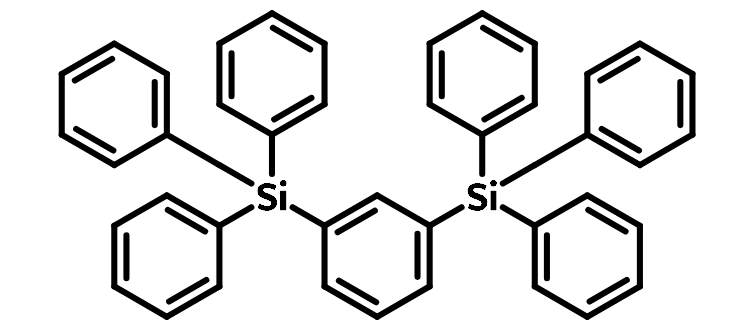UGH3
CAS Number 18920-16-6
High Purity Sublimed Materials, Host Materials, Materials, OLED Materials, Semiconducting Molecules, TADF Host Materials,UGH3, host for highly efficient blue PHOLEDs
High purity (>99.0%) effective HBL material
UGH3, 1,3-bis(triphenylsilyl)benzene, is an isomer to UGH-2, 1,4-bis(triphenylsilyl)benzene.
UGH3 is an ultrahigh energy gap (4.40 eV) organosilicon compounds and a weak electron-transport-type host for highly efficient blue PHOLEDs. UGH3 has a high triplet energy (ET=3.1 eV) and can also be used as a host material to dilute exciplex, to enhance TADF-OLED optical and electrical device performance. Having a deep HOMO energy level (7.2 eV), UGH3 can also be used as an effective hole blocking layer material.
Both UGH2 and UGH3 have low glass transition temperatures (Tg) below 100 °C. BSB, 4,4'-di(triphenylsilyl)-biphenyl, however, offers better morphology of OLED device films for higher device performance and stability with higher Tg at 100 °C.
General Information
| CAS number | 18920-16-6 |
|---|---|
| Chemical formula | C42H34Si2 |
| Molecular weight | 594.89 g/mol |
| Absorption | λmax 265 nm in THF |
| Fluorescence | λem 418 nm |
| HOMO/LUMO | HOMO = 7.20 eV, LUMO = 2.80 eV, ET =3.1 eV [1] |
| Full chemical name | 1,3-Bis(triphenylsilyl)benzene |
| Synonyms | UGH-3 |
| Classification / Family | Phosphorescent blue host material, Hole blocking materials, Sublimed materials |
Product Details
| Purity | Sublimed >99.0% (HPLC) |
|---|---|
| Melting point | Tg = 46 °C, TGA: >280 °C (0.5% weight loss) |
| Appearance | White powder/crystals |
*Sublimation is a technique used to obtain ultra pure-grade chemicals. For more details about sublimation, please refer to the sublimed materials.
Chemical Structure

Device Structure(s)
| Device structure | ITO (70 nm)/NPB (40 nm)/mCP (7.5 nm)/UGH3:FIrpic:Bt2Ir(acac) (14%, 0.3%) (30 nm)/UGH3 (5 nm)/Bphen (50 nm)/LiF (1 nm)/Al (120 nm) [2] |
|---|---|
| Colour | White |
| Max. Current Efficiency | 47.5 cd/A |
| Max. EQE | 18.9 % |
| Max. Power Efficiency | 36.6 Im/W |
| Device structure | ITO (70 nm)/NPB (40 nm)/mCP (7.5 nm)/UGH3:mCP (7:3):14 wt%FIrpic:0.3 wt% Bt2Ir(acac) (30 nm)/UGH3 (5 nm)/Bphen (50 nm)/LiF (1 nm)/Al (120 nm) [2] |
|---|---|
| Colour | White |
| Max. Current Efficiency | 47.6 cd/A |
| Max. EQE | 18.9 % |
| Max. Power Efficiency | 40.9 Im/W |
| Device structure | ITO/NPB (40 nm)/TSBPA (10 nm)|TSBPA:PO-T2T 1:1 in 50 vol % UGH-3 (40 nm)|POT2T (50 nm)|LiF (1 nm)|Al (100 nm) [3] |
|---|---|
| Colour | Green |
| Max. EQE | 19.2 % |
Pricing
| Grade | Order Code | Quantity | Price |
|---|---|---|---|
| Sublimed(>99.0% purity) | M2270A1 | 100 mg | £250 |
| Sublimed(>99.0% purity) | M2270A1 | 250 mg | £500 |
| Sublimed(>99.0% purity) | M2270A1 | 500 mg | £800 |
| Sublimed(>99.0% purity) | M2270A1 | 1 g | £1300 |
MSDS Documentation
Literature and Reviews
- Arylsilanes and siloxanes as optoelectronic materials for organic light-emitting diodes (OLEDs), D. Sun et al., J. Mater. Chem. C, 3, 9496-9508 (2015); DOI: 10.1039/C5TC01638J.
- Improved Performance of White Phosphorescent Organic Light-Emitting Diodes through a Mixed-Host Structure, ETRI. J., 31 (6), 642-646 (2009); J. Lee et al., DOI: 10.4218/etrij.09.1209.0005.
- Less Is More: Dilution Enhances Optical and Electrical Performance of a TADF Exciplex, M. Colella et al., J. Phys. Chem. Lett., 10, 793−798 (2019); DOI: 10.1021/acs.jpclett.8b03646.

 UGH3 MSDS sheet
UGH3 MSDS sheet